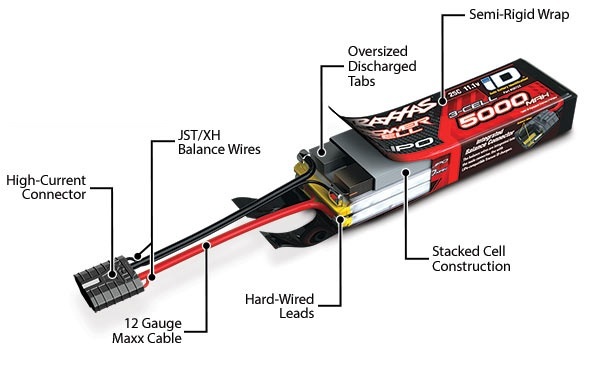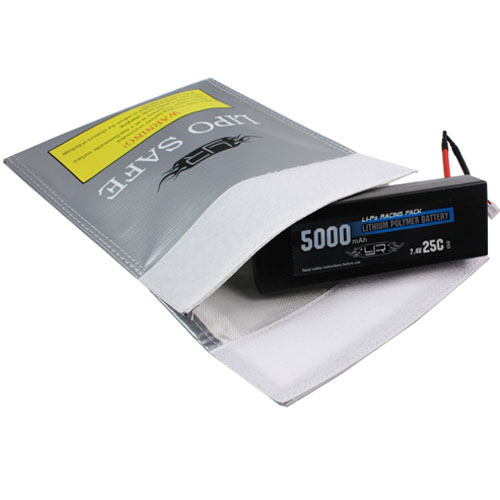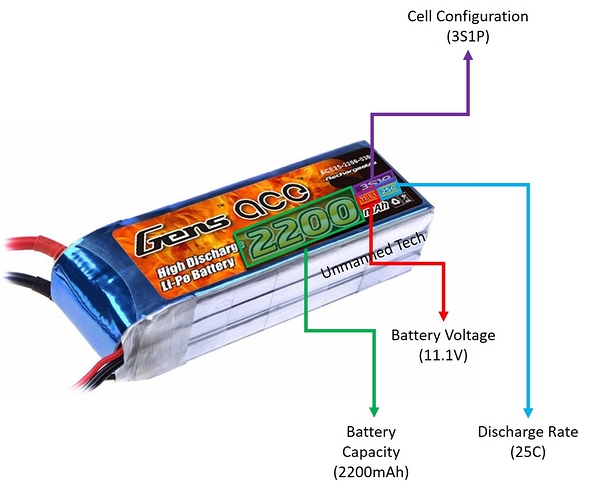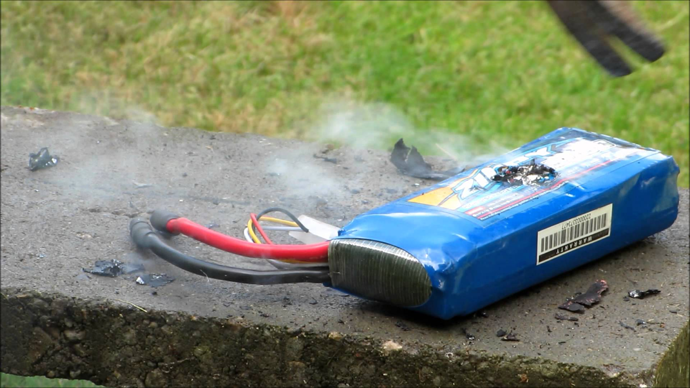In this beginners guide to LiPo batteries I will discuss what LiPo batteries are, what types to you get, and what all the numbers mean and how to properly look after your LiPo battery. At the end of this guide you will know how to properly use and look after your LiPo batteries to get the most out of them.
What is a LiPo Battery
A LiPo battery powers all of the electronics, and motors on your drone,. The difference with LiPo batteries and the ones you would use in your TV remote is the chemicals used in the battery. LiPo batteries are based on Lithium Polymer chemistry (hence the name LiPo) which allow these batteries to have a very high energy density compared to other types of batteries. A battery with a higher energy density will be able to hold more energy compared to another battery of the same weight which is why LiPo batteries are commonly used with R/C aircraft and drones.
There are other types of batteries such as nickel cadmium (NiCad) or nickel–metal hydride (NiMH), however these are seen as older battery technology and are not really used anymore because they are very heavy and dont hold much energy compared to LiPos.

A LiPo battery is constructed from individual cells, where each cell consists of some metal and chemicals packaged together to generate an electrical charge. By connecting these cells together in various ways we are able to make different LiPo batteries with various voltages, and capacities. More on that later on
What the numbers mean
We will now discuss what all of the numbers mean that specify a LiPo battery. This wil help you to know what you are buying and how to choose the correct LiPo for your application
Cells
A battery is constructed from rectangular cells which are connected together to form the battery. A cell which can be considered a battery in itself, holds a nominal voltage of 3.6V. By connecting more of these in series, the voltage can increase to 7.2V for a 2 cell battery, 11.1V for a 3 cell battery and so on. By connecting more batteries in parallel the capacity can be increased. Often you will see numbers like 3S2P, which mean the battery as 3 cells (3S) connected in series, and there are 2 cell sets connected in parallel (2P) , giving a total number of 6 individual sells in the battery.
So the number of cells is what defines the voltage of the battery. Having a higher voltage means the battery can provide more power to drive bigger motors, however more power does not necessarily mean the battery will provide energy for longer, that is defined by the battery capacity.
Voltages
Each cell in your LiPo battery has a nominal voltage of 3.6V. However when you use the battery the voltage will drop down, but it is important not to let this minimum voltage drop below 3.0V. Similarly you must ensure that the maximum voltage for a lipo cell is 4.2V. If the voltage of any cell in your Lipo battery goes beyond this range you can cause the chemicals to become unstable which can cause a fire ![]() so for this reason Lipo battery chargers are designed to ensure you only charge each cell to 4.2V. Similarly most ESC’s have a cut off voltage which turns off the motor when the voltage of your battery gets low to avoid discharging it too much.
so for this reason Lipo battery chargers are designed to ensure you only charge each cell to 4.2V. Similarly most ESC’s have a cut off voltage which turns off the motor when the voltage of your battery gets low to avoid discharging it too much.
Some multi-rotor ESC’s have this feature disabled as a motor suddenly turning off would result in your drone crashing. However most multi-rotor flight controllers have a way to monitor the battery voltage and warn you before it gets too low.
Capacity
The capacity of a battery is a representation of how long it can provide energy for, often quoted in mili Amp hours, (mAH). The bigger this number, the more capacity the battery has, so it can run your motors for longer. However the higher the capacity of a battery, the heavier it is so there is always a trade off between the battery capacity and weight for your aircraft.
Discharge Rate
The discharge rate is a very important specification to check when buying a battery. This number, also known as the battery C rating (or continuous C rating) defined how fast you can extract the energy from your battery. If your motors draw more energy that what you battery can provide, you can possibly damage your battery which can result in you crashing your drone. We discuss how to ensure the discharge rate is sufficient for your drone in our how to choose a LiPo Battery for your drone guide. To work out the actual current in Amps you simply multiply the capacity by the C vaue. So a 2200mAh battery with a C rating of 25C would have a continous current output of 25 x 2.2 = 55A continuous current output
Some batteries also specify a burst discharge rate (burst C), value represents the extra discharge the battery can provide for short periods of time usually 15-30 seconds.
How to Charge a LiPo Battery Safely
When it comes to charging your LiPo battery is very important to never leave a LiPo to charge unsupervised, I have read a few too many stories of fires ![]() starting because someone did not monitor their batteries while they where charging. Most of the time fires start because inferior b-grade LiPo batteries are used. If you use premium brand Lipo batteries such as GensAce you will not need to worry as they have all undergone rigorous safety tests and have the certifications to prove it. Here I will discuss a few rules you must follow while charging your batteries.
starting because someone did not monitor their batteries while they where charging. Most of the time fires start because inferior b-grade LiPo batteries are used. If you use premium brand Lipo batteries such as GensAce you will not need to worry as they have all undergone rigorous safety tests and have the certifications to prove it. Here I will discuss a few rules you must follow while charging your batteries.
Before i get into the rules I also wanted to state that I am assuming you are using a LiPo battery charger. If you don’t know much about LiPo battery chargers check out our Lipo charger buying guide.
- Never charge your battery unattended - from time to time check to see if your battery is getting warm to the touch or starts to sewll, if so stop charging immediately and contact an expert immediately (like someone on dronetrest) before using the battery again.
- Never charge a damaged battery - dont charge if it is swollen (puffy) or has any other visible signs of damage
- Always charge your battery at 1C or less - many chargers allow you to set a charging rate, although most batteries can support up to 5C charge rates (which makes charging your battery much faster). Its always best to charge at 1C or less as this means the chemicals inside your battery will gain energy slower which keeps them more stable and ultimately means your battery will have a much longer life in terms of charge/discharge cycles.
- Try to charge your batteries in a fireproof location, or in a lipo safe bag. - this just adds an extra layer of protection
- Ensure the number of cells and battery type are set correctly on your charger to match the cell count in your battery. - this is only applicable for more advanced chargers.
During the charge process the battery charger will constantly monitor the voltages of each cell and charge/discharge them to ensure they all the same. This is known as balance charging which all Lipo battery chargers do.
How to safely store a LiPo Battery
As mentioned before, Lipo batteries have a voltage range per cell for the chemicals to stay stable. However when it comes to storing your LiPo battery ![]() there are some best practices to ensure you get the most life out of it.
there are some best practices to ensure you get the most life out of it.

- You should always store your battery at 3.8V per cell (40% to 50% charge). This is why whenever you receive a battery, it will only be half charged. If you are flying on a regular basis (every few days) then this is less important as it will not have any noticeable effect if left fully charged for a few days, but if storing for a week or more you should ensure it is at around 50% charge.
- Always store your batteries in a fireproof location. You can always use a Lipo Safe back which is made from fire resistant material.
- Ensure the batteries are stored at room temperature.
How to choose the best LiPo for your drone
Now that you have an idea about what a LiPo battery is, you should check out our guide on how to choose a LiPo Battery for your drone:
Bonus: How LiPo Batteries are made
If you are interested in how batteries are made here is a great video from teh DIscover TV show, how stuff is made. Its slightly old but still gives you a great overview on how the batteries are made for anyone who is interested ![]() .
.
If you have any questions or tips about LiPo batteries please feel free to add a comment below.


